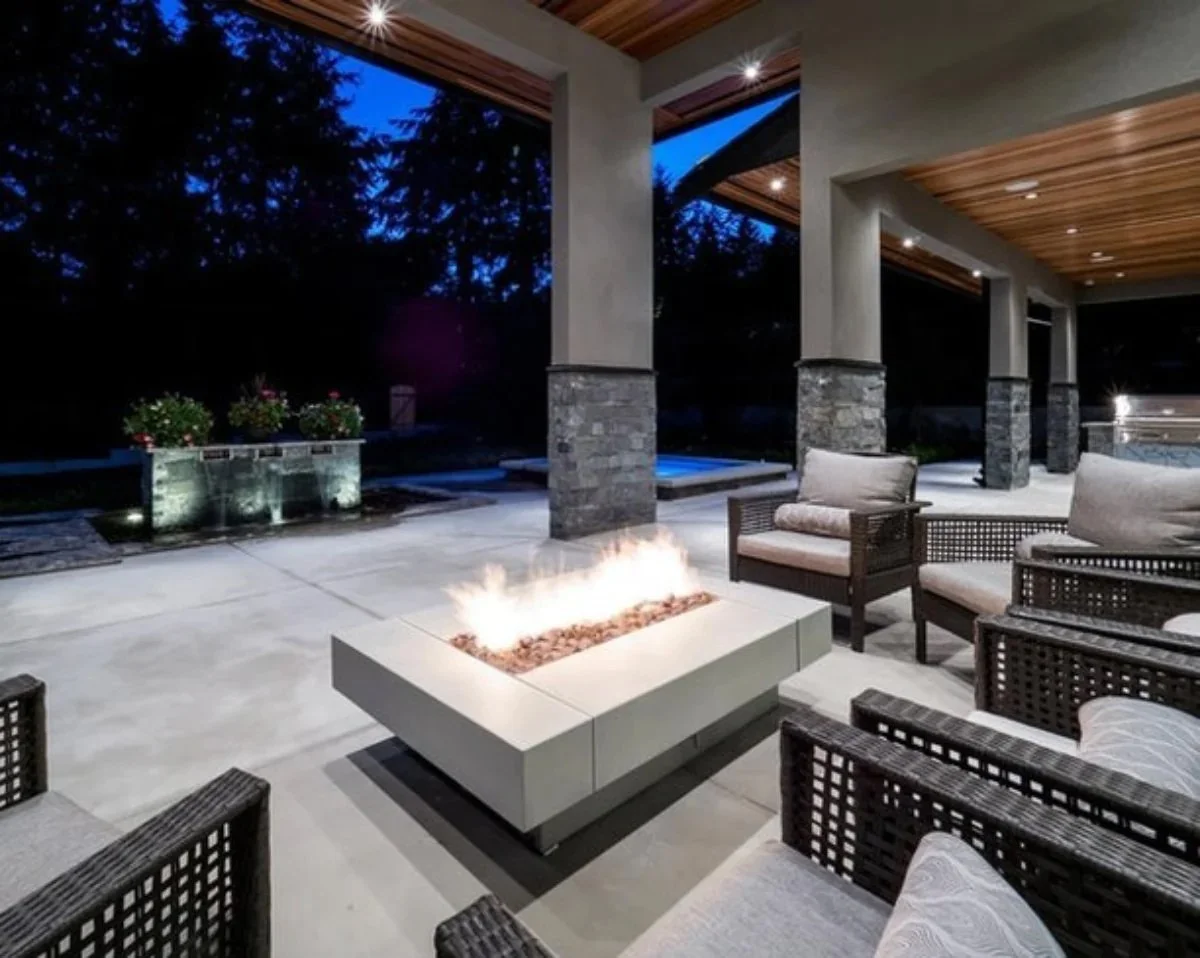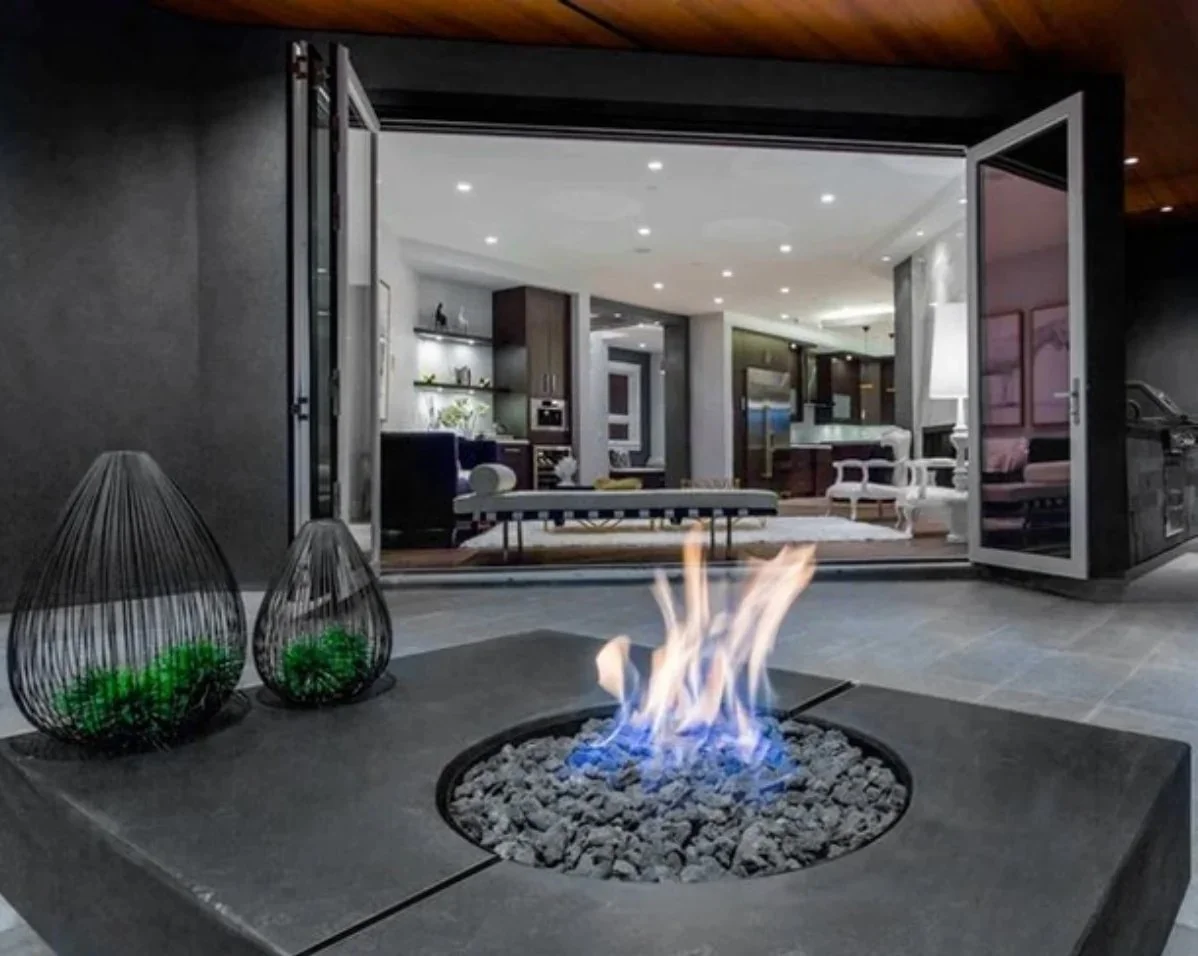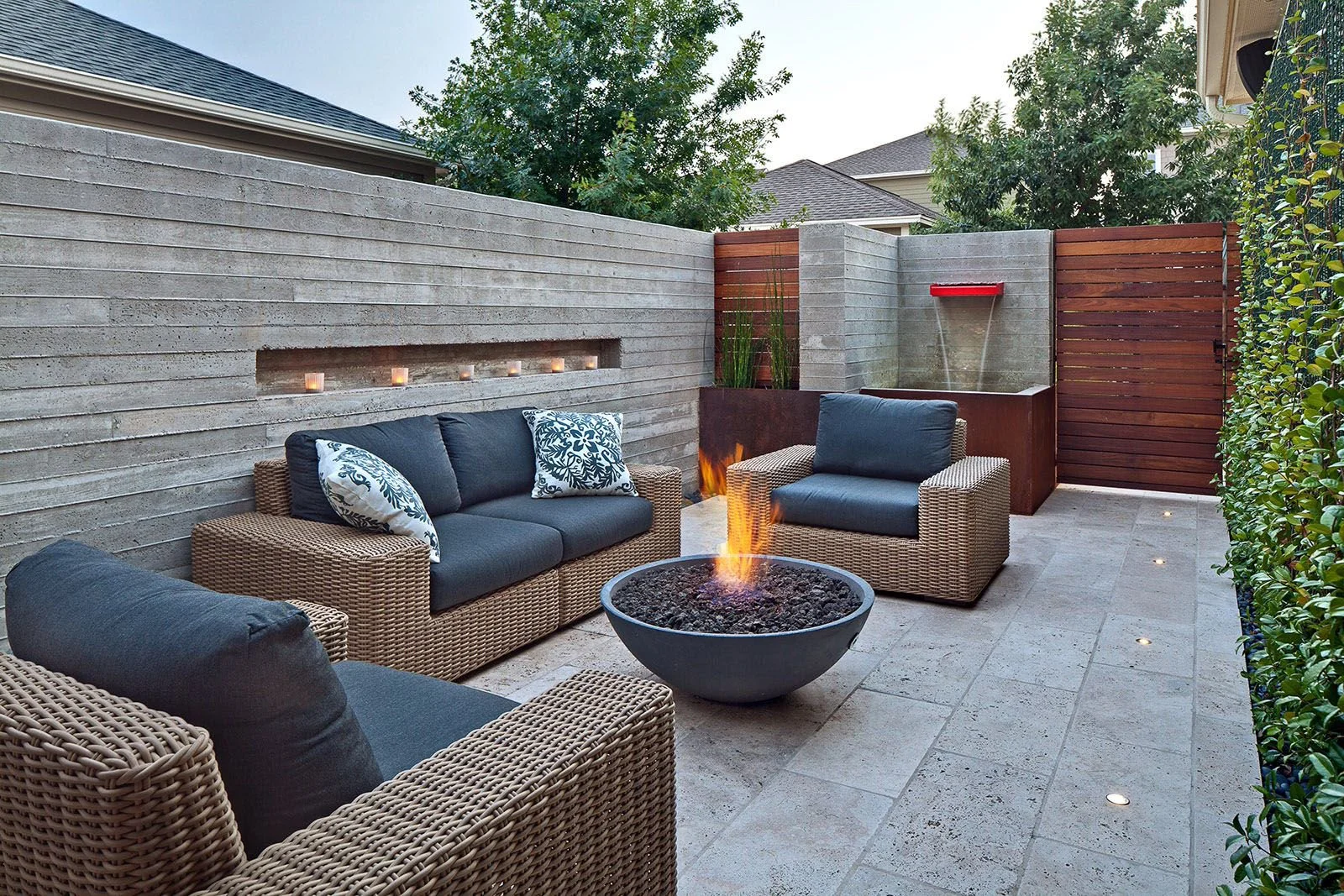Gas Fire Pit Construction: Commercial Fire Pit Design Requirements & Considerations
Fire features are a must-have for all residential and commercial spaces. We see an element of fire in hotel foyers, rooftops, pool decks, restaurants, decks and backyards, and especially in most award-winning designed spaces.
These fire features—whether in a form of the torch, fire table surrounded by seating, or a large fire bowl on a high pedestal—add an additional design element that elevates the space.
Commercial fire pits come in three forms: permanent, stationary, and portable. The type of fuel used depends on the type of fire pit purchased. For permanent or stationary installations, fire pits are typically fueled by natural gas. Most portable fire pits use propane.
Adding fire pits can elevate a space to grandeur, but having an open fire can also come with dire consequences if not maintained properly and used in a safe way. Today, we will be discussing commercial gas-fueled fire pits and tables that are suitable for an outdoor application.
Image from Joey B's. Photo credit: Matt Marcinkowski.
Commercial Fire Pit Design Requirements
What is the intended use of the fire pit?
When selecting the correct commercial fire pit, the following, at least, need to be taken into consideration. Will the fire pit be used to add warmth, to elevate the atmosphere, or both? Once you know the purpose of the fire pit, it is important to consider the location and whether you will need a permanent, stationary, or portable fire pit. Below are a few things you will need to take into consideration when selecting a fire pit based on the intended use.
Add warmth
Minimal BTU rating to have adequate warmth for the designed space
Amount of space needed to walk between the fire pit and the front of the seating area
Space needed around the flame, if the outer rim of fire pit will be used as a table to set items on
Whether a glass shield is needed
Is a manual or automated (electronic ignition) approved gas burner going be used
Does the fire pit installation need to be permanent, stationary, or portable
Elevate the atmosphere of the space
Ensure there isn't any chance for loose clothing or hair to accidentally catch on fire
BTUs are not as much as a concern as the size of the flame might be
What types of fuel sources will be used?
Natural Gas
Natural gas is delivered to residential and commercial buildings through leakproof pipelines. This type of fuel is used for permanent and stationary fire pits and connected to the line located in your home or building.
Natural gas is significantly less expensive than other fuel options, but having everything installed and connected by a professional may cost you more upfront. Natural gas is thought to be more convenient since it doesn’t need to be “refilled” once hooked up.
Propane (Liquified Petroleum Gas)
This gas is transported in an approved container that can be purchased much like one for a barbecue and can be used for a commercial fire pit. In some circumstances, large holding tanks are connected to a building or home, and then an additional line is connected to the fire pit. Liquefied petroleum gas can be either propane or a mix of propane and butane, depending on the temperatures of your region.
Propane is more expensive, but also twice as efficient as natural gas. Some people opt for a propane tank so they can use them for their outdoor grills as well.
Modern and attractive propane tank covers that protect and conceal your tank can be purchased. Or if a raised table is used, the tank can be accessed under the table or a deck as there will be a hose connecting the burner in the fire pit to the tank.
What are fire pit standards?
When purchasing an outdoor decorative gas appliance, ensure the fire pit has been tested and carries a certification, which usually is found on the manual. The certification reads ‘certified for USA or Canada’ and/or a certification mark. The American National Standards Institute (ANSI) is a not-for-profit organization that oversees the development of standards as well as promoting standards for products. They create the codes that products are tested against. The code for Outdoor Decorative Gas Appliances is ANSI Z21.97 in the US or CSA2.41 in Canada.
Outdoor fire pits are not considered a functional appliance. As such, they are a decorative appliance aptly named an ‘attended appliance.’ This is because there is an assumption that when they are on, there is someone looking after the fire.
The code has standards each product must satisfy. Here is a list of items the fire pit must satisfy before it is deemed safe and then display the certification mark.
This list is meant for information purposes only and is not complete. Please visit the ANSI website to download a complete list.
Placement
Permanent
Stationary
Portable products
Clearance to Combustible
There are recommendations of how far away combustible materials can be from a fire pit. This is to ensure the items around the fire pit do not get too hot and accidentally start a fire. The materials around and below the fire pit need to withstand at least 90°F.
Ventilation
It is important to install fire elements with enough space to ventilate the carbon monoxide that is produced. Typically an outdoor space can have up to 800PPM CO in the air from the fire pit
Ignition
There are many ignition options for fire pits. Here are a few examples:
Match lit: Gas is turned on then a match, or manual igniter is lit and then ignites the gas
Spark: A button is pushed to create a spark and ignites a flame after the gas is turned on
Electronic: A switch is turned on, and the flame appears
Fuels
Natural gas
Liquified petroleum gas
Bioethanol
Wind
The fire pit needs to ignite and operate safely in 10 MPH wind. The burners in the fire pit must operate safely or shut down properly at a maximum of 31 MPH wind.
Rain
There is a recent update to the rain test as of January 2020. The fire pit must operate during a rainstorm or shut off properly. And if it has an automatic starter, it must function properly and not be an electrical hazard.
Snow
There is no snow test at this time.
Sub Zero
The elements in the fire pit must be able to handle - 40°F and are usually tested to 32°F.
Burner Construction
The burner construction is tested to ensure it is suitable for outdoor use and resists corrosion.
Exposed Glass Surface
There are new requirements for exposed glass surfaces that are on fire pits as of January 2020. When the room (ambient) temperature is 77°F (25°C), the temperature of the glass should not exceed 172°F (78°C) to decrease the chance of burning a hand that touches the glass.
What permits are needed for a commercial fire pit?
Residential Rules
When deciding if a permit is needed, call your county or state permit line and inquire. Most gas fire features do not need a permit for residential applications, except for the installation of the new gas line, which the National Fire Institute (NFI) recommends is installed by a certified gas specialist. If you go to this link, you can look for one in your zip code.
If a permit is not required to add a fire pit to your residence, the NFI has resources to determine best practices. If an NFI certified gas specialist is installing your line, they may also have recommendations.
Commercial Spaces
For commercial spaces—and to ensure a business does not incur any liability claims—we suggest that you call your county to attain the proper permits. This will ensure none of your customers are inadvertently harmed while in your business.
Commercial Fire Pit Considerations
Fire Proof Materials
Ensure the materials being used to hold the burner are able to sustain high temperatures. If they are not able to sustain high temperatures, they could create a hazard of flying debris. If the fire pit has been tested and complies with the standards of ANSI Z21.97, you do not have to be concerned about fireproof materials.
Using a Shield
Glass barriers can be added to fire tables and pits. They help protect the fire from the wind and can keep young children from getting too close to the flame. You might also prefer how your fire pit looks with a glass barrier around the flame.
The only caveat is that the shields temperature cannot rise above 172°F (78°C) when the ambient temperature is 77°F (25°C). This is to prevent burns from people touching the glass.
Fire Controls
Whether a fire pit is wired for an automatic lit burner or a manual lit, there are ways to adjust the amount of gas available to the burner, which will allow the user to adjust the flame height. Depending on the space the flame height can be to account for high winds that might occur at ocean side vs. in an enclosed outdoor restaurant patio with little wind.
Distance of Fire Pit
When planning an outdoor space complete with a fire pit or table, ensure that the space feels comfortable enough to move between the chairs and the fire feature safely as well as around the seating and the perimeter of the room. In addition, since the fire pit is being used to create some warmth, keep in mind the minimum BTU that is required.
The number of seats needed around the fire will help determine the size of the fire pit required as well as the minimal distance required from any type of building or structure, combustible material of any form, or property line. Every city, county, and state may have suggested distances which need to be taken into account.
Communicating with a designer specializing in outdoor spaces will help with this, but one thing to think about is the suggested spacing between a couch and a coffee table. Kelsey Interiors suggests a distance of 12 to 18 inches from the seat to the coffee table.
In order to help with determining the amount of BTU’s needed in the outdoor space, a space calculator could be used to get at least an estimate of BTU’s that might be needed. This calculator is not meant for outdoor spaces but it would be a good start. We recommend finding a designer that specializes in outdoor spaces who is knowledgeable about which size of fire pit to choose for the space and the number of seats to add.
Keep the Flame Centered
The burner must be at least four inches from the edge of the fire pit. If there is a need for a space to put drinks on the rim of the fire pit, the flame should be at least twelve inches from the rim.
Don’t Bury the Burner
When installing the burner, make sure to follow the manufacturer's directions which will ensure optimal performance of the flame. Adding too much material can be a hazard. If the incorrect material is used, the flame will not perform as expected.
Away from High Trafficked Areas
If placing the fire pit by a front entrance, pool, or waiting area in a restaurant, it is important to provide adequate access to move around the fire element. This is so hair, little fingers, or flowing clothing does not catch on fire.
Create Rules for Seating
Most individuals understand that fire is dangerous, so ensure people stay at least 3 feet from the flame and act safe.
Consider the Weather
The weather can negatively impact your experience with a fire pit and damage the fire pit itself. However, there are several things you can do to protect the fire pit from the elements. One, cover the fire pit when not in use. Two, limit the use of the fire pit in the summer months, in locations where heat tends to reach excessive temperatures.
Fire pits usually have a drainage hole for extra water to disperse. But, after a large amount of snow or rain, we recommend making sure the fire pit is dry before operating it.
Image from J Square architecture. Photo credit: Patrick Y Wong.
Extinguisher Systems & Accessibility
A fire extinguisher should always be accessible when the commercial fire pit is in use. If in the event of a fire, the gas needs to be quickly turned off. This can be done with an automatic switch or with the key that turns the gas off manually.
There are five basic types of fire extinguishers that are specific for different types of fire fuel. In this circumstance, the fire from the gas in the burner could be potentially snuffed out by a class C fire extinguisher. However, the better choice is to turn the gas off completely. If items such as cloth or something in the surrounding space catch on fire, a class A fire extinguisher needs to be available. Fortunately, one fire extinguisher can be purchased to cover both of these types of fires, so look for one that can extinguish a class A and B.
How to use a fire extinguisher:
P: Pull the pin. Hold the extinguisher with the nozzle pointing away from you and release the locking mechanism.
A: Aim low. Point the extinguisher at the base of the fire.
S: Squeeze the lever slowly and evenly.
S: Sweep the nozzle from side-to-side.
We highly recommended that users take a class on how to work a fire extinguisher. Create a plan for all employees and residents to be familiar with what to do in the event of the unforeseen.
Certifications
Ensure that the fire pit is certified to satisfy the standards created by CSA and ANSI, and that they follow the codes CSA 2.41 (Canada) and ANSI Z21.97 (United States).
High Altitude Install
Gas fireplaces are tested and approved for elevations from 0 to 4,500 feet in Canada and USA. When installing fire pits at an elevation above 4,500 feet, check with local authorities. Consult your local gas utility for assistance in determining what design factors might need to be taken into account.
Carbon Monoxide
For an outdoor fire pit, it is recommended that not more than 800ppm carbon monoxide is dispersed. Therefore, having adequate ventilation is imperative to prevent carbon monoxide poisoning.
Care and Maintenance
Covering the fire pit when not in use is the best way to protect the fire pit and the burner from the weather. A cover is recommended for fire pits to prevent debris from causing issues with the burner and decrease the amount of rain and snow that drain through the fire pit.
Safety is the first concern when adding any type of fire feature to a residential or commercial space. Having a designated person who is in charge of the fire will ensure that someone will be looking out for the safety of all present.
PureModern carries commercial fire pits and tables that are available in various sizes to fit many different outdoor room sizes. Please click here to see commercial fire pits with and without rims as well as commercial fire tables with various widths to set items on.






